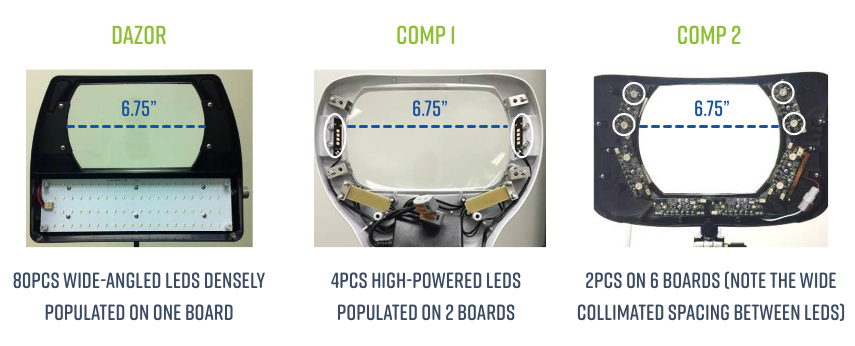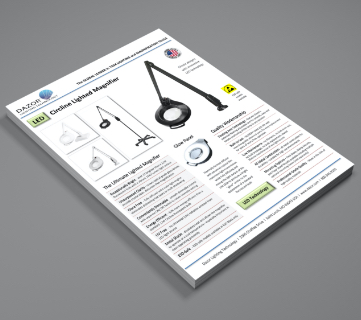Better Light Engine Design
The design of the "light engine" is a critical factor in measuring the performance of a lighted magnifier and they are not all created equally. In addition to outfitting our magnifiers with the crisp, glare-free viewing the elimination of inspection challenges is achieved by installing more high-quality LEDs to a more intelligently designed layout, then applying superior diffusion for associated with multi-shadowing and hot spots LED color and CRI, they also feature a superior light engine design.
More LEDs
Using more LEDs populated in close proximity and electrically not driving them hard, does some good things. First, placing them close together allows the maximum amount of “mixing” to occur just beyond the surface of the LEDs. Secondly, by running the LEDs at a lower electrical drive current, they operate cooler and will last their full rated life. Our competitors design their light engines with fewer LEDs and drive them harder electrically in order to save component part cost. Over the long term, that isn’t good for the end-user.

Better Diffusion
Diffusers are an incredibly important component of an LED light engine design that are often ignored by many magnifier manufacturers. This is unfortunate because without a well thought out diffuser, the light pattern emitted will not be mixed properly and can create multiple shadows. The light emitted from Dazor’s light engine is a smooth, diffuse, even “glow” – some say it even looks like a “glow panel.”
Next, our diffuser is made from an optical grade material specifically designed for high light transmission in LED applications. It allows over 90% of the LED light emitted to pass through which means less power to the LEDs so they can run cooler and last significantly longer. Others often use a piece of opaque plastic that absorbs up to 50% of the light, forcing the manufacturer to over-drive the LEDs which in turn, shortens their life.

Eliminates Multi-shadowing
Multi-shadowing is directly related to the selection and layout of LEDs on a board, plus how the emitted light is diffused as part of the total light engine design. In the image below you can see how the Dazor Stretchview magnifier uses 80 wide-angled LEDs densely populated on one board while competing magnifiers use significantly fewer LEDs spaced much further apart.
The lack of LEDs and poor design of most competing magnifiers leads to this multi-shadowing effect. This is a big problem when light is used for close proximity inspection viewing as the multi-shadowing is a major viewing distraction. It can potentially cause defects to be overlooked, reduce productivity and even cause eye fatigue.

Glare-free Viewing with No "Hot Spots"
The intuitive design and layout of our light engine creates a glare-free view with high color accuracy and no "hot spots" or wash out.
When doing close proximity inspection of reflective surfaces like pc boards, it’s critical the light source be designed to minimize reflections and glare. Dazor’s light engine accomplishes this by emitting light evenly and diffusing it properly. Others employ multiple beams of collimated light that create the hot spots that distract ones viewing, reduce productivity, cause eye strain and lead to defects to being overlooked.





